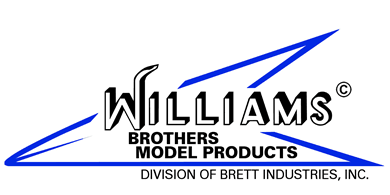
Williams Bros - Crankcase Howto

The following photos and text were submitted by Jim Landon of Denver Colorado.
(Email: TheGreatLandoni@Hotmail.com).
He built this LeRhone engine for a static display model for the "Wings Over the Rockies" museum there. Hopefully some of these ideas will prove helpful to R/C model builders as well.
 |
This is how I started the crankcase. I first drew a nine-sided polygon on the computer, then sawed it out with my scroll saw. Normally you would use the nice template that comes with each 1:12 scale Williams Brothers cylinder kit, but my engine needed to be undersized to fit the 1:14 scale model I was building. |
 |
According to the drawings and photos I had of LeRhone engines, the next "layer" of the crankcase needed to be a round disk. I couldn't find a steel washer the right size, so I found some wood the right thickness and used my scroll saw to cut out a disk the right diameter to fit the cylinder intake pipes. I then used my drill press as a makeshift lathe to smooth it closer to a perfect circle. |
 |
I searched through all my bolts and nuts and washers until I found a washer the right thickness and diameter to simulate the bolt flange. I made a template and center punched the bolt locations. At first I tried using small drops of epoxy for bolt heads, but it flowed out into oversized pools, so I later switched to tiny plastic nuts from my spares box. |
 |
The next "layer" needed to be dome shaped. Because I have installed many radio controlled garage door openers, I was familiar with carriage bolts. The domed head of a carriage bolt was the first thing that popped into my head. I chucked the bolt into my drill press and let it do the work while I held the hack saw in position. |
 |
In this photo I am trying to determine whether the nine 1:12 scale Williams Brothers cylinders are going to fit around the undersized crankcase, and still fit inside the 1:14 scale engine cowl. |
 |
In this photo the dome has been installed on the crankcase. It's epoxied to the steel washer behind it (which was previously epoxied to the wood disk behind it, which was previously glued to the 9-sided wood part). Also, one of the 1:12 scale Williams Brothers cylinders is sitting in place just to try to visualize how the engine is going to look. The "drive shaft" is a 3/16" drill bit, most of which is out of sight in a chunk of 2 X 4 behind the white paper. |
 |
This is a staged photo of the last of the nine engine cylinders being installed. The next steps (no photos) were to install the pushrods and intake pipes. I used little pieces of tubing to simulate the fittings where the pushrod enters the crankcase. I used little pieces of plastic rod stock to simulate the bolts that attach the intake pipes to the crankcase and to the cylinder heads. The finished engine appears elsewhere on this page. |
 |
This photo shows the wood piece I made to hold the rear end of the engine drive shaft in place inside the fuselage. It also shows the drive shaft -- an ordinary drill bit. If you look closely you can see a white nylon bearing that I found at the hardware store and installed in the wood piece. There's another nylon bearing just like it in the firewall, which is the front support for the drive shaft. Also notice the spark plug wires on the rear of the engine. The rear of the engine won't be visible after the model plane is finished, so I didn't worry about it's appearance, but the spark plug wires will be visible to anyone who examines the engine through the openings in the engine cowl. |
 |
This is the completed model engine. |
 |
This photo shows how I determined how much space was required between the firewall and the engine, in relation to the position of the engine cowl to the fuselage. This was critical because the engine just barely clears the inside of the engine cowl, when properly positioned. Various combinations of spacers and washers were tested and measurements were taken for the amount of drive shaft that needed to extend forward of the firewall to provide the right amount to extend through the propeller. |
 |
This is a "staged" photo of how the front end of the model airplane would look. For this photo, everything was held in place on a 3/16 drill bit that goes into a 2 X 4 behind the scene. I ended up keeping the drill bit as the crank shaft because I liked the way it looked and, well, why not? |


